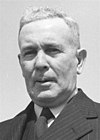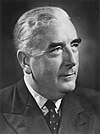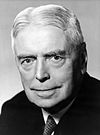User:Norcandy/Sandbox/PM: Difference between revisions
Jump to navigation
Jump to search
(Created page with ";Parties {{legend2|#6B7194|National Party|border=1px solid #AAAAAA}} {{legend2|#B3A67A|Nasionale Hervorming|border=1p...") |
No edit summary |
||
| Line 75: | Line 75: | ||
|[[Daan van Brietenbach|van Brietenbach I]]-[[Daan van Brietenbach|II]] | |[[Daan van Brietenbach|van Brietenbach I]]-[[Daan van Brietenbach|II]] | ||
|- | |- | ||
| colspan="6"|{{small|Daan van Brietenbach replaced Daniël Wilson as Prime Minister in 1961. A controversial figure, he deeply divided the National Party, and his actions would lead to its ultimate demise. Ordered mass crackdowns on civil unrest and introduced various racial laws that the National Party had previously refrained from implementing. He remained as Prime Minister until his | | colspan="6"|{{small|Daan van Brietenbach replaced Daniël Wilson as Prime Minister in 1961. A controversial figure, he deeply divided the National Party, and his actions would lead to its ultimate demise. Ordered mass crackdowns on civil unrest and introduced various racial laws that the National Party had previously refrained from implementing. He remained as Prime Minister until his assassination by a lone gunman from one of the few remaining native tribes in Satavia whilst leaving a summit with leaders of the provincial governments.}} | ||
|- style="background:#EEEEEE" | |- style="background:#EEEEEE" | ||
! style="background:#6B7194; color:white;" rowspan="2"|21 | ! style="background:#6B7194; color:white;" rowspan="2"|21 | ||
| Line 99: | Line 99: | ||
|[[Altus Meyer|A. Meyer]] | |[[Altus Meyer|A. Meyer]] | ||
|- | |- | ||
| colspan="6"|{{small|Altus Meyer, despite being 71 and in ill | | colspan="6"|{{small|Altus Meyer, despite being 71 and in ill health was chosen to lead the party and become Prime Minister. Two factions that had formed in the National Party could not agree on a successor so longtime party member Meyer was chosen as a compromise. Ultimately, Meyer was too ill to deal with the stress of the premiership and was incapacitated for most of his time in office. Died in office.}} | ||
|- style="background:#EEEEEE" | |- style="background:#EEEEEE" | ||
! style="background:#; color:black;" rowspan="2"|— | ! style="background:#; color:black;" rowspan="2"|— | ||
| Line 123: | Line 123: | ||
|[[Hendrik Botha|Botha I]]-[[Hendrik Botha|II]] | |[[Hendrik Botha|Botha I]]-[[Hendrik Botha|II]] | ||
|- | |- | ||
| colspan="6"|{{small|Botha, who had previously been serving as Chief of the Satavian Defence Forces, was picked by the Nasionale Hervorming (National Reform) wing of the National Party as their candidate to take the premiership. Botha's National Party | | colspan="6"|{{small|Botha, who had previously been serving as Chief of the Satavian Defence Forces, was picked by the Nasionale Hervorming (National Reform) wing of the National Party as their candidate to take the premiership. Botha's National Party opponent committed suicide two days before the election, although this claim is disputed by many. Botha, under intense international pressure in the form of sanctions, began several internal reforms that saw the country open up. At odds with President Willem Pieters, who thought that this would lead to the end of National Party rule. Ultimately, with laws against protests relaxed huge demonstrations were staged in the capital, Port Hope, and across the country. Botha ordered the Hope Province Provincial Guard to crush the demonstrators in Port Hope; the Provincial Guard disobeyed his orders, and led by [[Johannes Klopper]] they seized the Parliament Buildings and residences of the President and Prime Minister, arresting Botha and ending National Party leadership.}} | ||
|- | |||
|} | |||
Revision as of 15:19, 15 May 2022
- Parties
National Party Nasionale Hervorming
| No. | Portrait | Name (Birth–Death) Constituency |
Term of office | Elected (Parliament) |
Political party | Government | ||
|---|---|---|---|---|---|---|---|---|
| Took office | Left office | Time in office | ||||||
| 16 | 
|
Field Marshal Oscar Harrision (1893-1941) — |
13 February 1939 | 28 April 1941 | 2 years, 74 days | — | National | O. Harrison |
| Harrison lead the February Coup against Edward Limes' government in 1939, and thereafter began the proccess of dismantling democracy in Satavia. Harrison was assassinated by members of the pro-democracy SRA in April 1941. | ||||||||
| 17 | 
|
Johan van Velix (1865-1941) — |
28 April 1941 | 23 December 1941 | 239 days | — | National | J. van Velix |
| Johan van Velix took power following the assasination of Field Marshall Harrison in April that year. In his eight-month stint as Prime Minister, van Velix vowed to avenge the death of Harrison and declared martial law across the country. He suffered a stroke and died later that year. | ||||||||
| 18 | 
|
General Christiaan Pienaar (1899-1972) MP for Division of Harris, Hope Province |
23 December 1941 | 17 June 1949 | 7 years, 176 days | — | National | Pienaar I-II-III |
| Pienaar, who had served as Treasurer in both Oscar Harrison and Johan van Velix's governments, took over when van Velix suffered a stroke and died in December 1941. Pienaar lead a huge crackdown on Leftists and any dissent whatsoever. Resigned in 1949 so as to replace Edward Collingham as President. | ||||||||
| 19 | 
|
Daniël Wilson (1904-2001) MP for Division of Grange Lake, Hope Province |
17 June 1949 | 3 March 1961 | 11 years, 259 days | — | National | Wilson I-II-III-IV |
| Daniël Wilson replaced Christiaan Pienaar when he stepped down to replace Collingham as President of Satavia. Wilson had served as Governor of the Hope Province in the years prior to his ascendency to the position of Prime Minister. During his tenure, Wilson further restricted civil liberties and authorised the crushing of the 1955 Satavian riots, which was condemned internationally. He stepped down in 1961, and became President two years later when Arthur Lindsey retired. | ||||||||
| 20 | 
|
Daan van Brietenbach (1907-1969) — |
3 March 1961 | 9 November 1969 | 8 years, 251 days | — | National | van Brietenbach I-II |
| Daan van Brietenbach replaced Daniël Wilson as Prime Minister in 1961. A controversial figure, he deeply divided the National Party, and his actions would lead to its ultimate demise. Ordered mass crackdowns on civil unrest and introduced various racial laws that the National Party had previously refrained from implementing. He remained as Prime Minister until his assassination by a lone gunman from one of the few remaining native tribes in Satavia whilst leaving a summit with leaders of the provincial governments. | ||||||||
| 21 | 
|
Edward Malir (1922-1999) — |
9 November 1969 | 18 January 1970 | 70 days | — | National | E. Malir |
| Serving as Treasurer at the time of Daan van Brietenbach's assasination, Malir was chosen to replace him. Malir proved to be weak and incapable, and was replaced by Altus Meyer after just two months. | ||||||||
| 22 | 
|
Altus Meyer (1899-1971) — |
18 January 1970 | 2 July 1971 | 1 year, 165 days | — | National | A. Meyer |
| Altus Meyer, despite being 71 and in ill health was chosen to lead the party and become Prime Minister. Two factions that had formed in the National Party could not agree on a successor so longtime party member Meyer was chosen as a compromise. Ultimately, Meyer was too ill to deal with the stress of the premiership and was incapacitated for most of his time in office. Died in office. | ||||||||
| — | 
|
Keith Bernstein (1909-1982) — |
2 July 1971 | 29 July 1971 | 27 days | — | Caretaker government | Bernstein caretaker |
| The National Party's two factions were now locked in a power struggle, and so senior civil-servant and Cabinet Secretary Kieth Bernstein was appointed to lead a caretaker administration whilst a government was formed. His administration lasted less than a month. | ||||||||
| 23 | 
|
General Hendrik Botha (1933-) — |
29 July 1971 | 27 September 1976 | 5 years, 60 days | — | Nasionale Hervorming | Botha I-II |
| Botha, who had previously been serving as Chief of the Satavian Defence Forces, was picked by the Nasionale Hervorming (National Reform) wing of the National Party as their candidate to take the premiership. Botha's National Party opponent committed suicide two days before the election, although this claim is disputed by many. Botha, under intense international pressure in the form of sanctions, began several internal reforms that saw the country open up. At odds with President Willem Pieters, who thought that this would lead to the end of National Party rule. Ultimately, with laws against protests relaxed huge demonstrations were staged in the capital, Port Hope, and across the country. Botha ordered the Hope Province Provincial Guard to crush the demonstrators in Port Hope; the Provincial Guard disobeyed his orders, and led by Johannes Klopper they seized the Parliament Buildings and residences of the President and Prime Minister, arresting Botha and ending National Party leadership. | ||||||||